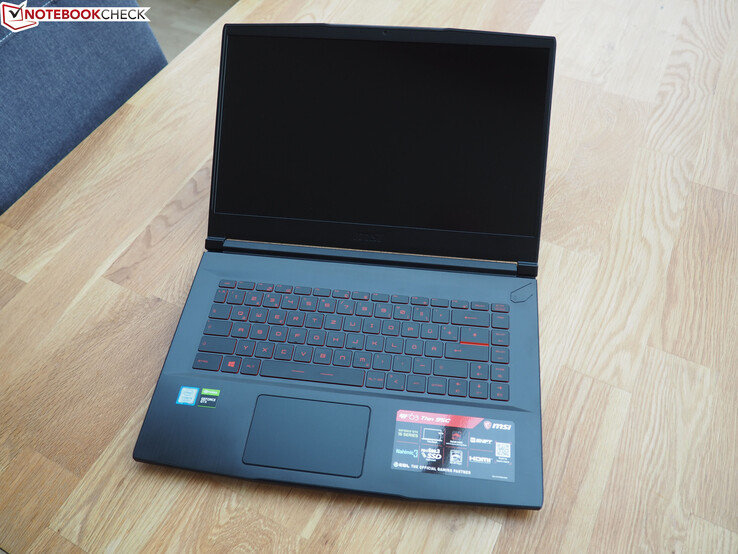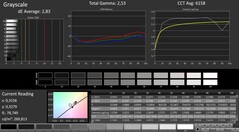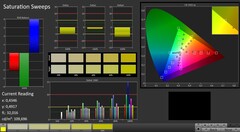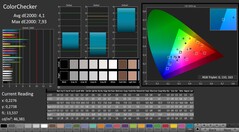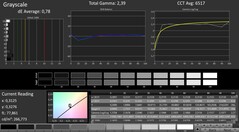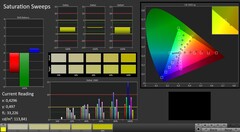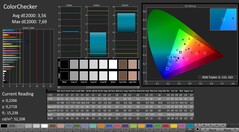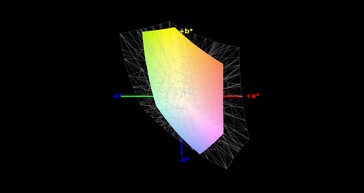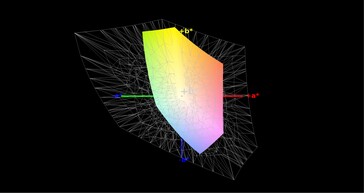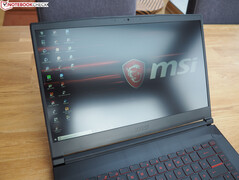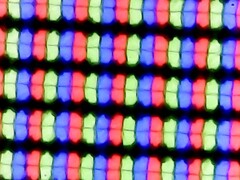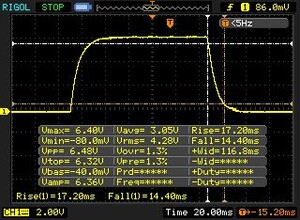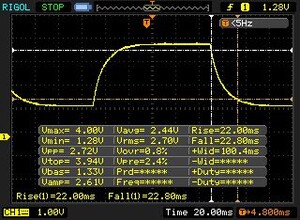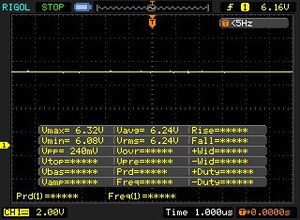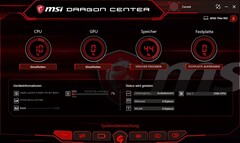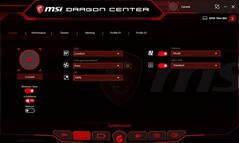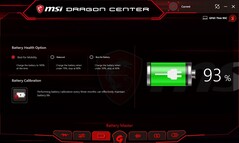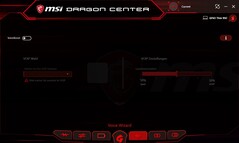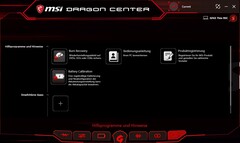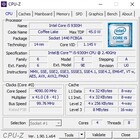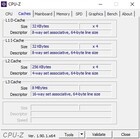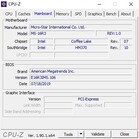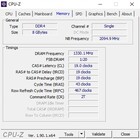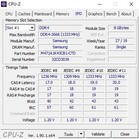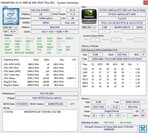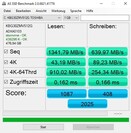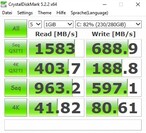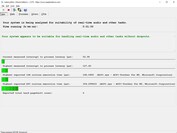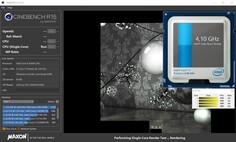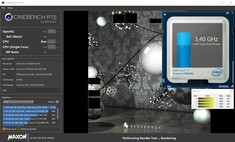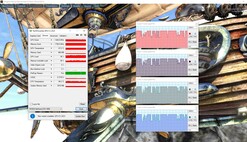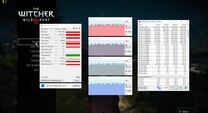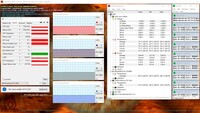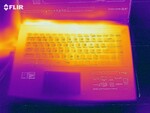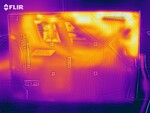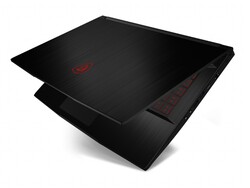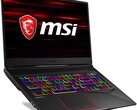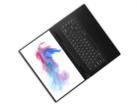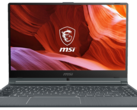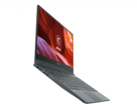MSI GF63 Thin 9SC Laptop Review: Lightweight gamer for just under $1000

The GF63 Thin 9SC from MSI is directed at occasional gamers who wouldn't (want to) spend over $1000 dollars for a notebook. The device is 2.2 cm (~0.9 in) thick and weighs 1.8 kg (~3.9 lb), which is fairly slim and light for a 15-inch notebook. It has a good selection of components and is equipped with Intel's quad-core processor Core i5-9300H, 8 GB of DDR4 RAM (single channel) and a 512-GB SSD. The energy-efficient Max-Q version of the mid-range GeForce GTX 1650 takes care of the graphics department. The images it produces are displayed on a matte IPS display with 1920x1080 pixels.
The competition of the GF63 9SC includes other 15-inch laptops that are equipped with a Core i5-9300H and a ("normal") GeForce GTX 1650 such as the Dell G5 15 5590, the Acer Aspire Nitro 5 AN515, the HP Omen 15 or the Lenovo IdeaPad L340-15IRH. These notebooks have been included in our review as comparison devices.
Rating | Date | Model | Weight | Height | Size | Resolution | Price |
|---|---|---|---|---|---|---|---|
| 77.6 % v7 (old) | 01 / 2020 | MSI GF63 Thin 9SC i5-9300H, GeForce GTX 1650 Max-Q | 1.8 kg | 22 mm | 15.60" | 1920x1080 | |
| 79.6 % v7 (old) | 10 / 2019 | Dell G5 15 5590-PCNJJ i5-9300H, GeForce GTX 1650 Mobile | 2.7 kg | 23.7 mm | 15.60" | 1920x1080 | |
| 82.5 % v6 (old) | 05 / 2019 | Acer Aspire Nitro 5 AN515-54-53Z2 i5-9300H, GeForce GTX 1650 Mobile | 2.2 kg | 27 mm | 15.60" | 1920x1080 | |
| 81.5 % v7 (old) | 07 / 2019 | HP Omen 15-dc1020ng i5-9300H, GeForce GTX 1650 Mobile | 2.3 kg | 25 mm | 15.60" | 1920x1080 | |
| 77 % v7 (old) | 09 / 2019 | Lenovo IdeaPad L340-15IRH 81LK00BMGE i5-9300H, GeForce GTX 1650 Mobile | 2.1 kg | 23.9 mm | 15.60" | 1920x1080 |
As the case is identical with that of its predecessor (Core i5-8300H & GeForce GTX 1050), we will not be discussing the case, connectivity and input devices in this review. Please refer to the predecessor's review or details on these aspects.
| Networking | |
| iperf3 transmit AX12 | |
| MSI GF63 Thin 9SC | |
| iperf3 receive AX12 | |
| MSI GF63 Thin 9SC | |
Display
Like most budget gamers, the display has a Full-HD resolution and 60 Hz. Faster panels with 120 or 144 Hz are usually only available beyond the $1000 price point.
| |||||||||||||||||||||||||
Brightness Distribution: 92 %
Center on Battery: 260 cd/m²
Contrast: 1130:1 (Black: 0.23 cd/m²)
ΔE ColorChecker Calman: 4.1 | ∀{0.5-29.43 Ø4.79}
calibrated: 3.56
ΔE Greyscale Calman: 2.83 | ∀{0.09-98 Ø5}
56% sRGB (Argyll 1.6.3 3D)
36% AdobeRGB 1998 (Argyll 1.6.3 3D)
39.01% AdobeRGB 1998 (Argyll 3D)
56.5% sRGB (Argyll 3D)
37.76% Display P3 (Argyll 3D)
Gamma: 2.53
CCT: 6158 K
| MSI GF63 Thin 9SC AU Optronics B156HAN02.1 (AUO21ED), IPS, 1920x1080 | Dell G5 15 5590-PCNJJ AU Optronics B156HAN (AUO23ED), IPS, 1920x1080 | Acer Aspire Nitro 5 AN515-54-53Z2 LG LP156WFC-SPD1 (LGD0563), IPS, 1920x1080 | HP Omen 15-dc1020ng LGD05CE, IPS, 1920x1080 | Lenovo IdeaPad L340-15IRH 81LK00BMGE CMN 156HCA-EAB, IPS, 1920x1080 | |
|---|---|---|---|---|---|
| Display | 115% | 1% | 2% | 13% | |
| Display P3 Coverage (%) | 37.76 | 83.1 120% | 37.97 1% | 38.37 2% | 42.81 13% |
| sRGB Coverage (%) | 56.5 | 99.9 77% | 57 1% | 57.6 2% | 63.8 13% |
| AdobeRGB 1998 Coverage (%) | 39.01 | 96.8 148% | 39.23 1% | 39.69 2% | 44.31 14% |
| Response Times | -1% | 11% | 9% | 1% | |
| Response Time Grey 50% / Grey 80% * (ms) | 44.8 ? | 48 ? -7% | 42 ? 6% | 40 ? 11% | 45.6 ? -2% |
| Response Time Black / White * (ms) | 31.6 ? | 30 ? 5% | 26.8 ? 15% | 29.6 ? 6% | 30.8 ? 3% |
| PWM Frequency (Hz) | 25910 ? | ||||
| Screen | -19% | -2% | -21% | -16% | |
| Brightness middle (cd/m²) | 260 | 234 -10% | 238 -8% | 251 -3% | 275 6% |
| Brightness (cd/m²) | 249 | 216 -13% | 226 -9% | 232 -7% | 253 2% |
| Brightness Distribution (%) | 92 | 87 -5% | 83 -10% | 76 -17% | 83 -10% |
| Black Level * (cd/m²) | 0.23 | 0.22 4% | 0.27 -17% | 0.17 26% | 0.18 22% |
| Contrast (:1) | 1130 | 1064 -6% | 881 -22% | 1476 31% | 1528 35% |
| Colorchecker dE 2000 * | 4.1 | 6.52 -59% | 4.11 -0% | 6.2 -51% | 5.4 -32% |
| Colorchecker dE 2000 max. * | 7.93 | 10.58 -33% | 6.89 13% | 18.6 -135% | 21.3 -169% |
| Colorchecker dE 2000 calibrated * | 3.56 | 3.56 -0% | 3.76 -6% | 4.8 -35% | 4.4 -24% |
| Greyscale dE 2000 * | 2.83 | 5.33 -88% | 1.78 37% | 4.2 -48% | 3.7 -31% |
| Gamma | 2.53 87% | 2.86 77% | 2.41 91% | 2.32 95% | 2.12 104% |
| CCT | 6158 106% | 5983 109% | 6311 103% | 7454 87% | 6376 102% |
| Color Space (Percent of AdobeRGB 1998) (%) | 36 | 36 0% | 36 0% | 36.5 1% | 40.8 13% |
| Color Space (Percent of sRGB) (%) | 56 | 57 2% | 57 2% | 57.4 3% | 63.6 14% |
| Total Average (Program / Settings) | 32% /
8% | 3% /
0% | -3% /
-13% | -1% /
-8% |
* ... smaller is better
The image quality of the GF63 9SC mirrors that of its competition. Thanks to the relatively low black value of 0.23 cd/m², the 15-inch screen has a decent contrast of 1130:1, which should satisfy most users.
The brightness is not as good. We measured an average of 259 cd/m², which should be enough for (dark) indoor spaces but isn't ideal in brighter surroundings. We usually recommend notebooks with at least 350 cd/m² for outdoor use. The panel's color space is also rather limited with a 56-percent coverage of the sRGB and a 36-percent coverage of the AdobeRGB color space. However, this is quite normal in the budget segment.
The response time isn't really impressive either. 31.6 ms black-to-white and 44.8 ms gray-to-gray can cause some ghosting during faster games (e.g. the soccer simulation game "FIFA"). At least the monitor offers the usual stable viewing angles that are typical for an IPS display. The color accuracy is decent ex-works.
Display Response Times
| ↔ Response Time Black to White | ||
|---|---|---|
| 31.6 ms ... rise ↗ and fall ↘ combined | ↗ 17.2 ms rise | |
| ↘ 14.4 ms fall | ||
| The screen shows slow response rates in our tests and will be unsatisfactory for gamers. In comparison, all tested devices range from 0.1 (minimum) to 240 (maximum) ms. » 85 % of all devices are better. This means that the measured response time is worse than the average of all tested devices (20.3 ms). | ||
| ↔ Response Time 50% Grey to 80% Grey | ||
| 44.8 ms ... rise ↗ and fall ↘ combined | ↗ 22 ms rise | |
| ↘ 22.8 ms fall | ||
| The screen shows slow response rates in our tests and will be unsatisfactory for gamers. In comparison, all tested devices range from 0.165 (minimum) to 636 (maximum) ms. » 75 % of all devices are better. This means that the measured response time is worse than the average of all tested devices (31.7 ms). | ||
Screen Flickering / PWM (Pulse-Width Modulation)
| Screen flickering / PWM not detected | |||
In comparison: 53 % of all tested devices do not use PWM to dim the display. If PWM was detected, an average of 8167 (minimum: 5 - maximum: 343500) Hz was measured. | |||
Testing conditions
The preinstalled Dragon Center gives users the possibility to make various adjustments to the system. The system tuner tab is particularly interesting. Our measurements were all made using the shift mode "comfort" (but we got exactly the same results in our short test using the gaming profile) and with the cooling fan set to automatic. The display profile was set to standard (MSI's RGB), the audio test is based on the "music" setting (Nahimic).
Performance
We will start with a series of system screenshots that display the most important components.
Processor
The Core i5-9300H currently is one of the most successful notebook processors available - particularly in the multimedia and gaming segment. The quad-core chip from Intel's Coffee Lake generation has a TDP of 45 watts and can work up to eight threads simultaneously thanks to hyper threading. The 8 MB of L3 cache and the clock rate of up to 4.1 GHz are quite promising as well.
However, the GF63 9SC cannot make full use of the CPU turbo. While single core applications are completed at a constant 4.0 to 4.1 GHz, the clock rate quickly drops to 3.4 GHz in multi core scenarios in which all cores are under load (tested in the CineBench R15). This causes the performance to drop by around 10%, but thankfully does not have an impact on the frame rate in most 3D applications.
In order to save energy while idling or during less demanding tasks including office, video and browsing, the MSI has equipped the GF63 9SC with Nvidia's Optimus technology which dynamically switches between the processor's graphics chip (in this case the UHD Graphics 630) and the dedicated GeForce GPU.
System Performance
The system performance is very good. With a total score of 4889 points, the GF63 makes second place among its competitors in the PCMark 10. Only the Acer Nitro 5 manages an even better rating. The device boots quickly and is as fast as you would expect a $1000 notebook to be.
Storage Device
The operating system (Windows 10 Home 64 bit) is installed on an M.2 drive from Toshiba. The 512-GB model KBG30ZMV512G reaches over 1000 MB/s during sequential reading. The write rates remain below expectations for PCIe/NVMe technology. Competing SSDs such as the WDC PC SN520 or SN720 do a significantly better job (see comparison table). The GF63 might seem a little slower than other budget gamers during heavy multi-tasking with high write rates (transferring files, installing software, ...). Users can add a 2.5-inch drive using the frame that is included in the scope of delivery.
| MSI GF63 Thin 9SC Toshiba KBG30ZMV512G | Dell G5 15 5590-PCNJJ KBG30ZMS128G | Acer Aspire Nitro 5 AN515-54-53Z2 WDC PC SN520 SDAPNUW-512G | HP Omen 15-dc1020ng WDC PC SN720 SDAQNTW-512G | Lenovo IdeaPad L340-15IRH 81LK00BMGE WDC PC SN520 SDAPMUW-512 | |
|---|---|---|---|---|---|
| CrystalDiskMark 5.2 / 6 | -43% | 48% | 105% | 34% | |
| Write 4K (MB/s) | 80.6 | 65.3 -19% | 109.1 35% | 112.1 39% | 103.6 29% |
| Read 4K (MB/s) | 41.82 | 29.71 -29% | 42.05 1% | 42.01 0% | 39.91 -5% |
| Write Seq (MB/s) | 597 | 128.8 -78% | 1457 144% | 1964 229% | 1160 94% |
| Read Seq (MB/s) | 963 | 859 -11% | 1421 48% | 2065 114% | 990 3% |
| Write 4K Q32T1 (MB/s) | 188.8 | 95.8 -49% | 287.8 52% | 318.2 69% | 283.4 50% |
| Read 4K Q32T1 (MB/s) | 403.7 | 197.6 -51% | 317.9 -21% | 406.7 1% | 344.5 -15% |
| Write Seq Q32T1 (MB/s) | 689 | 132.5 -81% | 1455 111% | 2534 268% | 1455 111% |
| Read Seq Q32T1 (MB/s) | 1583 | 1208 -24% | 1739 10% | 3438 117% | 1690 7% |
GPU Performance
The Nvidia GeForce GTX 1650 is the successor of the popular GeForce GTX 1050. It is no longer based on Pascal architecture but uses the more efficient Turing system.
| 3DMark 11 Performance | 10378 points | |
| 3DMark Cloud Gate Standard Score | 17713 points | |
| 3DMark Fire Strike Score | 7177 points | |
| 3DMark Time Spy Score | 3136 points | |
Help | ||
Compared to the "normal" GTX 1650, the Max-Q version that is used in the GF63 9SC manages to run on lower clock rates. It has a base clock rate of 1020 MHz instead of 1395 MHz. In practice, the chip reaches far higher clock rates thanks to its GPU boost (which works similarly to Intel's turbo boost). The GF63 reached 1440 MHz in the Unigine Heaven benchmark and 1400 MHz with very steady frame rates during our 60-minute test of "The Witcher 3". This shows that the cooling system must be very efficient.
All specifications apart from the clock rate are identical with the standard version of the GTX 1650. This includes 1024 shader units and 4 GB of GDDR5 VRAM with a 128-bit interface.
We did not notice any peculiarities during the various benchmarks. The 3D performance of the GF63 9SC is on par with that of other laptops that are equipped with a GTX 1650 Max-Q. According to 3DMark 13 and 11, notebooks that are equipped with the standard GTX 1650 are faster by about 13 - 19 percent.
Gaming Performance
The Nvidia GPU is usually fast enough to play games at high details and 1920x1080 pixels smoothly. Only more demanding or badly optimized titles such as "Metro Exodus", "Anno 1800", "Control", "Borderlands 3" and "Red Dead Redemption 2" may have difficulties in these settings and users will have to reduce to medium details to play these games.
| The Witcher 3 | |
| 1920x1080 High Graphics & Postprocessing (Nvidia HairWorks Off) | |
| Average of class Gaming (110 - 424, n=39, last 2 years) | |
| HP Omen 15-dc1020ng | |
| Acer Aspire Nitro 5 AN515-54-53Z2 | |
| Dell G5 15 5590-PCNJJ | |
| MSI GF63 Thin 9SC | |
| 1920x1080 Ultra Graphics & Postprocessing (HBAO+) | |
| Average of class Gaming (18.4 - 240, n=61, last 2 years) | |
| HP Omen 15-dc1020ng | |
| Acer Aspire Nitro 5 AN515-54-53Z2 | |
| Lenovo IdeaPad L340-15IRH 81LK00BMGE | |
| Dell G5 15 5590-PCNJJ | |
| MSI GF63 Thin 9SC | |
If you do not want to make any compromises when playing more demanding games, would like to connect an external QHD or 4K monitor, or would appreciate having some reserves for future games, you might want to look for a configuration with at least a GeForce GTX 1660 Ti.
| low | med. | high | ultra | |
|---|---|---|---|---|
| The Witcher 3 (2015) | 146 | 99 | 53.2 | 30.4 |
| Apex Legends (2019) | 144 | 71.1 | 58.4 | 57 |
| Far Cry New Dawn (2019) | 72 | 52 | 49 | 46 |
| Metro Exodus (2019) | 73.3 | 36.9 | 27.5 | 22.6 |
| Dirt Rally 2.0 (2019) | 154 | 81.6 | 68.8 | 38.7 |
| The Division 2 (2019) | 82 | 56 | 45 | 32 |
| Anno 1800 (2019) | 60.4 | 52.2 | 34.7 | 18 |
| Rage 2 (2019) | 103 | 46.5 | 39.7 | 38.9 |
| F1 2019 (2019) | 127 | 83 | 69 | 46 |
| Control (2019) | 120 | 39.9 | 29.1 | |
| Borderlands 3 (2019) | 86 | 53.6 | 34.9 | 26 |
| FIFA 20 (2019) | 150 | 118 | 115 | 114 |
| Ghost Recon Breakpoint (2019) | 63 | 41 | 39 | 26 |
| GRID 2019 (2019) | 92.4 | 65.9 | 53.4 | 36.7 |
| Call of Duty Modern Warfare 2019 (2019) | 94.1 | 59 | 49.8 | 40.6 |
| Need for Speed Heat (2019) | 67.6 | 52.2 | 46.8 | 37.2 |
| Star Wars Jedi Fallen Order (2019) | 57.2 | 49.7 | 44.4 | |
| Red Dead Redemption 2 (2019) | 56.3 | 43.5 | 29.3 | 18.6 |
Emissions
System Noise
MSI might want to work on its fan control in future. The fact that the fans are permanently active while idling would not be a problem if they ran at low speed. As it is, they produce 35 to 37 dB(A), which is quite audible and louder than all comparison devices.
The noise emissions of the GF63 9SC are on par with the competition while idling. The 15-inch device is quieter than the Dell G5 5590 and the Acer Aspire Nitro 5 but louder than the HP Omen 15 and the Lenovo IdeaPad L340-15IRH at 41 to 44 dB(A). In general, its fan noise during 3D applications is fairly good for a gamer.
Noise level
| Idle |
| 35 / 36 / 37 dB(A) |
| Load |
| 44 / 43 dB(A) |
 | ||
30 dB silent 40 dB(A) audible 50 dB(A) loud |
||
min: | ||
| MSI GF63 Thin 9SC i5-9300H, GeForce GTX 1650 Max-Q | Dell G5 15 5590-PCNJJ i5-9300H, GeForce GTX 1650 Mobile | Acer Aspire Nitro 5 AN515-54-53Z2 i5-9300H, GeForce GTX 1650 Mobile | HP Omen 15-dc1020ng i5-9300H, GeForce GTX 1650 Mobile | Lenovo IdeaPad L340-15IRH 81LK00BMGE i5-9300H, GeForce GTX 1650 Mobile | Average of class Gaming | |
|---|---|---|---|---|---|---|
| Noise | -3% | 1% | 14% | 16% | 11% | |
| off / environment * (dB) | 30 | 30 -0% | 30 -0% | 28.8 4% | 28.4 5% | 24.1 ? 20% |
| Idle Minimum * (dB) | 35 | 31 11% | 30 14% | 28.8 18% | 28.4 19% | 26.1 ? 25% |
| Idle Average * (dB) | 36 | 32 11% | 31 14% | 29.5 18% | 28.4 21% | 27.6 ? 23% |
| Idle Maximum * (dB) | 37 | 35 5% | 33 11% | 31.1 16% | 28.4 23% | 30.2 ? 18% |
| Load Average * (dB) | 44 | 49 -11% | 46 -5% | 35.2 20% | 30.1 32% | 43 ? 2% |
| Witcher 3 ultra * (dB) | 41 | 47 -15% | 46 -12% | 35.2 14% | 40.2 2% | |
| Load Maximum * (dB) | 43 | 53 -23% | 49 -14% | 41 5% | 40.2 7% | 53.6 ? -25% |
* ... smaller is better
Temperature
The temperature development of our MSI notebook is average as well. Its maximum of 47 °C (~117 °F) on the top and bottom are quite acceptable and the case does not heat up particularly while idling. The average surface temperature of 23 - 24 °C (~73 - 75 °F) is comfortably cool.
You don't need to worry about the components. While the CPU and GPU reached around 70 °C (~158 °F) during the Witcher 3 test, the cores heated up to around 80 °C (~176 °F) during our stress test with FurMark and Prime95. This is quite moderate for a gaming device.
(-) The maximum temperature on the upper side is 47 °C / 117 F, compared to the average of 40.5 °C / 105 F, ranging from 21.2 to 68.8 °C for the class Gaming.
(-) The bottom heats up to a maximum of 47 °C / 117 F, compared to the average of 43.3 °C / 110 F
(+) In idle usage, the average temperature for the upper side is 23.8 °C / 75 F, compared to the device average of 33.9 °C / 93 F.
(-) Playing The Witcher 3, the average temperature for the upper side is 38.8 °C / 102 F, compared to the device average of 33.9 °C / 93 F.
(+) The palmrests and touchpad are reaching skin temperature as a maximum (32 °C / 89.6 F) and are therefore not hot.
(-) The average temperature of the palmrest area of similar devices was 28.9 °C / 84 F (-3.1 °C / -5.6 F).
| MSI GF63 Thin 9SC i5-9300H, GeForce GTX 1650 Max-Q | Dell G5 15 5590-PCNJJ i5-9300H, GeForce GTX 1650 Mobile | Acer Aspire Nitro 5 AN515-54-53Z2 i5-9300H, GeForce GTX 1650 Mobile | HP Omen 15-dc1020ng i5-9300H, GeForce GTX 1650 Mobile | Lenovo IdeaPad L340-15IRH 81LK00BMGE i5-9300H, GeForce GTX 1650 Mobile | Average of class Gaming | |
|---|---|---|---|---|---|---|
| Heat | -4% | 2% | 6% | -8% | -13% | |
| Maximum Upper Side * (°C) | 47 | 49 -4% | 47 -0% | 40.3 14% | 44.8 5% | 45.5 ? 3% |
| Maximum Bottom * (°C) | 47 | 55 -17% | 50 -6% | 48.5 -3% | 58.1 -24% | 48.1 ? -2% |
| Idle Upper Side * (°C) | 26 | 25 4% | 24 8% | 23.9 8% | 27.9 -7% | 31.5 ? -21% |
| Idle Bottom * (°C) | 26 | 26 -0% | 25 4% | 24.6 5% | 27.9 -7% | 34.3 ? -32% |
* ... smaller is better
Speakers
MSI GF63 Thin 9SC audio analysis
(+) | speakers can play relatively loud (86 dB)
Bass 100 - 315 Hz
(-) | nearly no bass - on average 19.5% lower than median
(±) | linearity of bass is average (10.9% delta to prev. frequency)
Mids 400 - 2000 Hz
(±) | higher mids - on average 7.7% higher than median
(±) | linearity of mids is average (9.9% delta to prev. frequency)
Highs 2 - 16 kHz
(+) | balanced highs - only 1.8% away from median
(+) | highs are linear (6.3% delta to prev. frequency)
Overall 100 - 16.000 Hz
(±) | linearity of overall sound is average (18.9% difference to median)
Compared to same class
» 62% of all tested devices in this class were better, 8% similar, 30% worse
» The best had a delta of 6%, average was 18%, worst was 132%
Compared to all devices tested
» 43% of all tested devices were better, 8% similar, 49% worse
» The best had a delta of 4%, average was 24%, worst was 134%
Dell G5 15 5590-PCNJJ audio analysis
(+) | speakers can play relatively loud (87 dB)
Bass 100 - 315 Hz
(-) | nearly no bass - on average 19.7% lower than median
(±) | linearity of bass is average (11.9% delta to prev. frequency)
Mids 400 - 2000 Hz
(±) | higher mids - on average 5.7% higher than median
(+) | mids are linear (4.9% delta to prev. frequency)
Highs 2 - 16 kHz
(±) | reduced highs - on average 6.5% lower than median
(±) | linearity of highs is average (9.6% delta to prev. frequency)
Overall 100 - 16.000 Hz
(±) | linearity of overall sound is average (17.4% difference to median)
Compared to same class
» 48% of all tested devices in this class were better, 12% similar, 41% worse
» The best had a delta of 6%, average was 18%, worst was 132%
Compared to all devices tested
» 32% of all tested devices were better, 8% similar, 60% worse
» The best had a delta of 4%, average was 24%, worst was 134%
Energy Management
Power Consumption
The power consumption of our test unit while idling is a little higher than that of its competition. But 7 - 9 watts can still be considered good for a gaming notebook. The Max Q design of the GPU is not that noticeable under load. The consumption of 73 - 164 watts could have come from a normal GTX 1650 laptop.
| Off / Standby | |
| Idle | |
| Load |
|
Key:
min: | |
| MSI GF63 Thin 9SC i5-9300H, GeForce GTX 1650 Max-Q | Dell G5 15 5590-PCNJJ i5-9300H, GeForce GTX 1650 Mobile | Acer Aspire Nitro 5 AN515-54-53Z2 i5-9300H, GeForce GTX 1650 Mobile | HP Omen 15-dc1020ng i5-9300H, GeForce GTX 1650 Mobile | Lenovo IdeaPad L340-15IRH 81LK00BMGE i5-9300H, GeForce GTX 1650 Mobile | Average of class Gaming | |
|---|---|---|---|---|---|---|
| Power Consumption | 9% | 8% | 9% | 20% | -86% | |
| Idle Minimum * (Watt) | 7 | 4 43% | 5 29% | 4.04 42% | 3.8 46% | 14.1 ? -101% |
| Idle Average * (Watt) | 9 | 7 22% | 7 22% | 7.2 20% | 6.6 27% | 20 ? -122% |
| Idle Maximum * (Watt) | 13 | 12 8% | 11 15% | 11.4 12% | 8.9 32% | 27 ? -108% |
| Load Average * (Watt) | 79 | 95 -20% | 89 -13% | 80.8 -2% | 78.4 1% | 111.3 ? -41% |
| Witcher 3 ultra * (Watt) | 73 | 86 -18% | 90 -23% | 93.6 -28% | 82 -12% | |
| Load Maximum * (Watt) | 164 | 135 18% | 132 20% | 144.5 12% | 124 24% | 262 ? -60% |
* ... smaller is better
Battery Life
Thanks to graphics switching, the GF63 9SC can boast a good battery life - although the 8.5 hours of runtime according to our Battery Eater Reader's test (minimum brightness) make our device second to last in our comparison field. The Dell G5 15, the Acer Nitro 5 and the HP Omen 15 all manage over 10 hours in this test. The 51-Wh battery in our test unit lasts around 4.5 hours during wireless browsing at medium brightness. Gaming sessions can be expected to last around 1 hour at maximum brightness. We were pleased that the 3D performance hardly dropped when the device was running on battery with the frame rate dropping from 31 to 29 FPS (1920x1080 pixels).
| MSI GF63 Thin 9SC i5-9300H, GeForce GTX 1650 Max-Q, 51 Wh | Dell G5 15 5590-PCNJJ i5-9300H, GeForce GTX 1650 Mobile, 60 Wh | Acer Aspire Nitro 5 AN515-54-53Z2 i5-9300H, GeForce GTX 1650 Mobile, 57 Wh | HP Omen 15-dc1020ng i5-9300H, GeForce GTX 1650 Mobile, 52.5 Wh | Lenovo IdeaPad L340-15IRH 81LK00BMGE i5-9300H, GeForce GTX 1650 Mobile, 45 Wh | Average of class Gaming | |
|---|---|---|---|---|---|---|
| Battery runtime | 79% | 71% | 44% | 5% | 27% | |
| Reader / Idle (h) | 8.5 | 14.5 71% | 17.4 105% | 15.9 87% | 7.8 -8% | 9.79 ? 15% |
| WiFi v1.3 (h) | 4.4 | 8 82% | 8.1 84% | 6.4 45% | 6.1 39% | 6.55 ? 49% |
| Load (h) | 1.2 | 2.2 83% | 1.5 25% | 1.2 0% | 1 -17% | 1.42 ? 18% |
| H.264 (h) | 8 | 7.74 ? | ||||
| Witcher 3 ultra (h) | 1 | 1.039 ? |
Pros
Cons
Verdict
If you leave aside the meagre port selection (no card reader, no DisplayPort, no Thunderbolt 3 or USB 3.1 Gen2), the fan control that could be improved (idle mode!) and the relatively dark and slow display, the MSI GF63 Thin 9SC does not have any major weaknesses.
The 15-inch gamer is compact, has a low weight and offers a good price-to-performance ratio, which should please gamers that are looking for both a portable and an affordable gaming notebook. Input devices, battery life, case quality and performance are all appropriate for this purchase price.
But this is a very competitive field and there are many similar or even better alternatives available from other manufacturers (e.g. Dell, Acer, HP & Lenovo).
MSI GF63 Thin 9SC
- 05/14/2020 v7 (old)
Florian Glaser




